
Total Solar Eclipse in Turkey, 2006
Eric and I visited Turkey in march/april, in order to witness the total solar eclipse on the 29th of march, 2006.
Many people who have never seen a total eclipse laugh at us for taking the trouble to go see one. Most of these people have seen a partial eclipse, and apparently it didn't make their hearts beat any faster. This is a citation from Jay M. Pasachoff, that I got from the book "Totality":
Some people see a partial eclipse and wonder why others talk so much about a total eclipse. Seeing a partial eclipse and saying that you have seen an eclipse is like standing outside an opera house and saying that you have seen the opera; in both cases, you have missed the main event.
Nobody who has seen a total eclipse laughs at us for going to see one, which sure says something. Seeing the effects of an eclipse on nature, the animals and people around you, is fascinating. The moment of totality is overwhelming. And if you stop to think about the sheer size of it all, about gigantic spheres racing around through space at incredible speeds, enormous distances away from each other, and then all aligning so perfectly, it's hard not to be awed.
We had seen the total solar eclipse of 1999, in France. This made such a large impression on us, that we decided we were going to try to see a couple more in our lifetimes. We missed a few in the early years of the milennium, in southern Africa. There was no reason not to go to Turkey though: it's very easy and ridiculously cheap to visit from Western Europe.
On this page you'll find (links within this page):
Description
We flew to Antalya on the 28th of march. On the morning of the 29th, we drove our rental car about 70 km eastward along the coast of the Turkish Riviera, to Manavgat. This town was roughly at the center of the band in which the sun was totally eclipsed, which means that the duration of the eclipse would be largest here. We drove northward from Manavgat, searching for a good spot for watching the eclipse.
The spot we were looking for would have to be on a hill high enough to offer a good view of the surrounding landscape. It had to have an especially good view toward the west, which is where the shadow of the moon would be coming from. In addition, it shouldn't be covered in trees, and there'd have to be roads leading up it. It took us about an hour to find "our" hill.
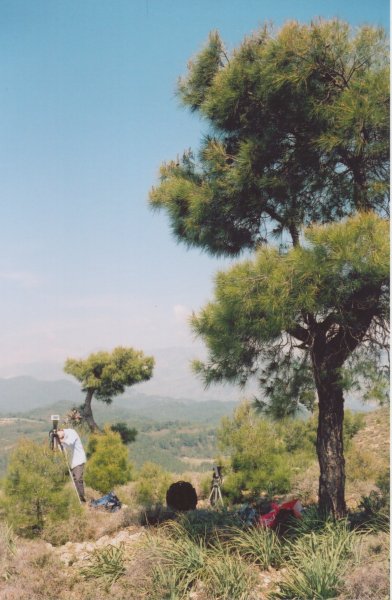
Setting up our gear.
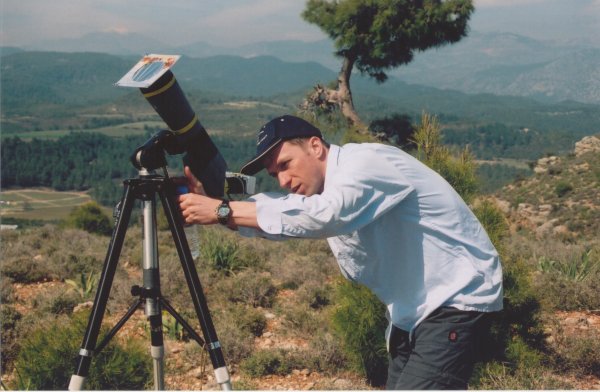
Eric is directing the telescope at the sun by looking at the camera's LCD screen.
See more details on our gear further down on this same page.
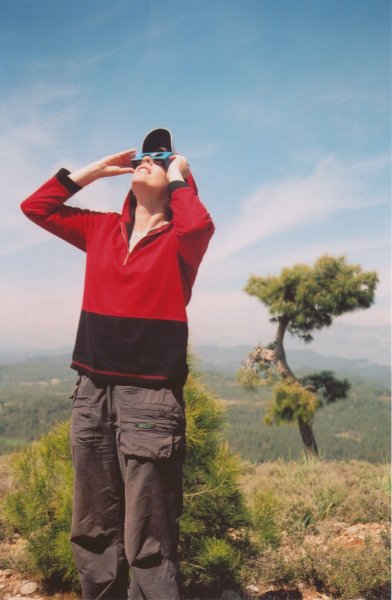
I don't feel one bit geeky wearing these glasses. Note that I'm wearing a sweater,
and that I even put up the hood for warmth.
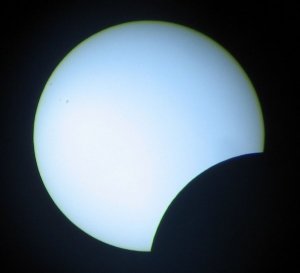


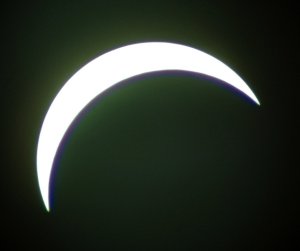
Four stages during the progressing partial eclipse, before totality.
[Photos taken through telescope, enlargement approximately 40x.]
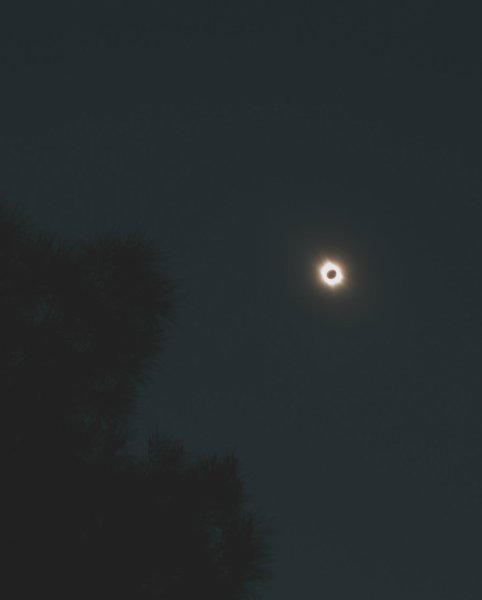
Totality. Note the darkness of the sky, and the branch of a tree at the bottom left.
This picture gives a good impression of what totality looks like with the naked eye.
[Photo taken with a digital SLR camera, with a 50 mm lens.]
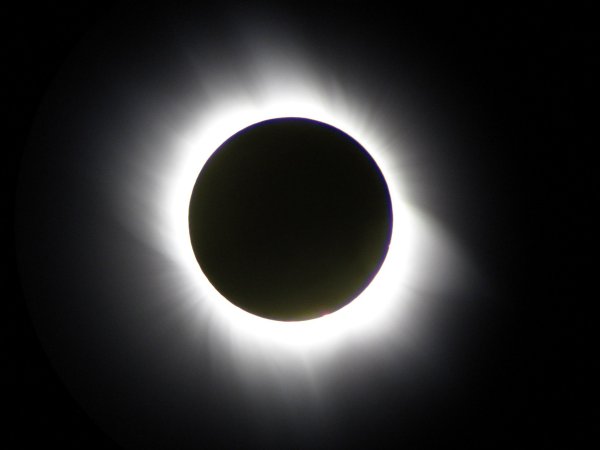
Totality. The disk of the moon is now completely obscuring the sun. The sun's corona
is clearly visible (the white flares all around the sun). Note that the end of totality is
approaching: small bright spots are appearing at the bottom right.
[Photo taken with a compact digital camera, through a telescope, enlargement approximately 40x]
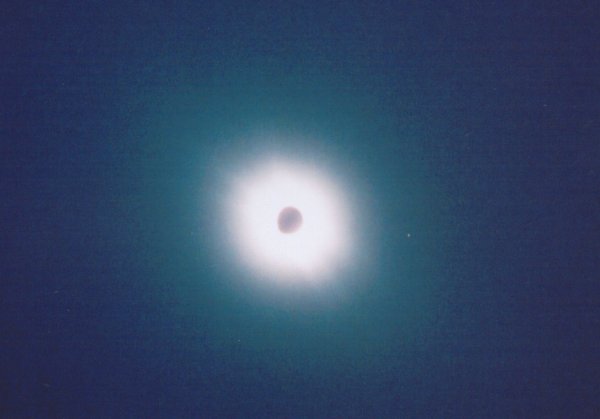
Totality, with different camera aperture settings.
[Photo taken with an analogue SLR camera.]
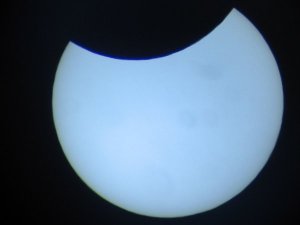
Partial eclipse after totality.
[Photo taken through telescope, enlargement approximately 40x.]
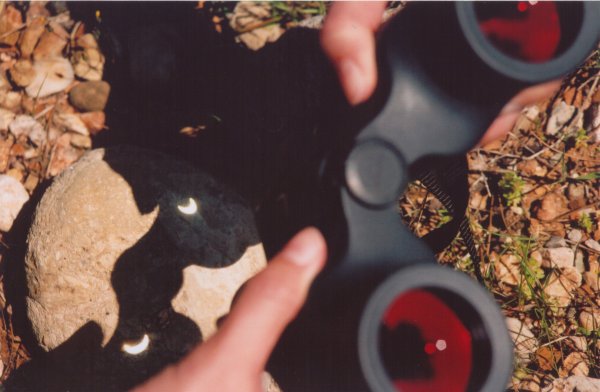
Projecting a partial eclipse through inverted binoculars.
Movie
When totality was just starting, we set the digital camera on the telescope to record a short movie. In order to be able to watch what was going on, rather than have to continually adjust the telescope, we used a relatively low magnification (20x - 30x). Now this is what I believe they call the Diamond Ring. Part of this movie is shown here (440 kb), if the movie has stopped, and you want to see it again, hit the "refresh" button on your browser.:
Google Earth Placemarker
Click here to see our location in Google Earth. Google Earth must already be installed. When prompted, select "open." Sometimes, the link below opens up a window showing a zipped file. Double-click on this file, and again select "open" to view the location in Google Earth.
More details on our gear
Telescope set-up:
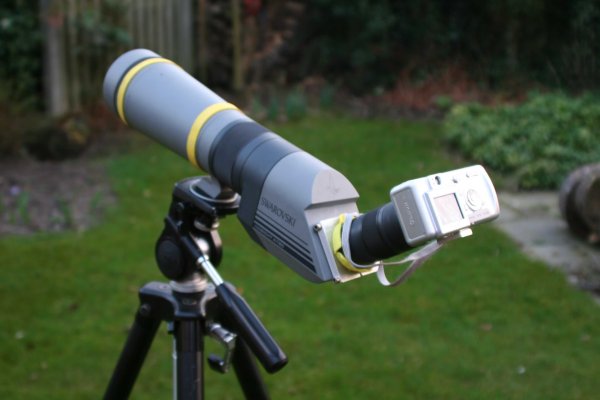
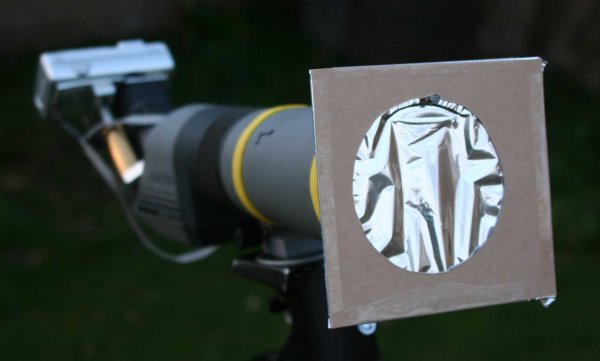
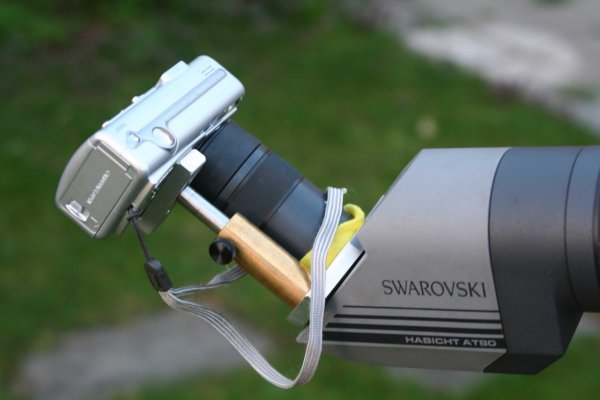
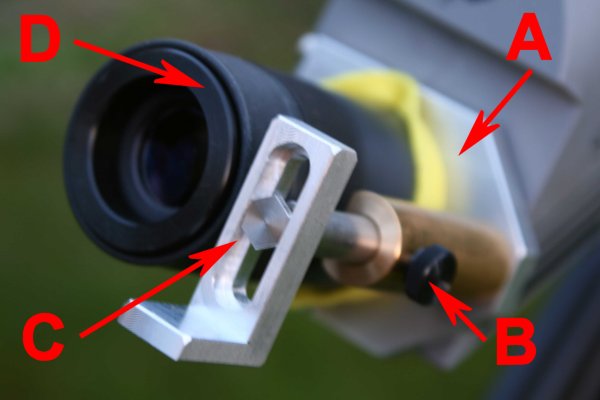
Part A clamps around the eyepiece (yellow felt prevents damage)
Part B is an arm that is adjustable in length
Part C is a camera holder that can be rotated to suit the camera position
Part D, finally, is the genius bit: a plastic ring fits in the eyepiece. Its outer diameter matches that of the telescope eyepiece, while its inner diameter fits just around the camera lens. This way, it holds the camera in place, and automatically aligns it with the telescope!
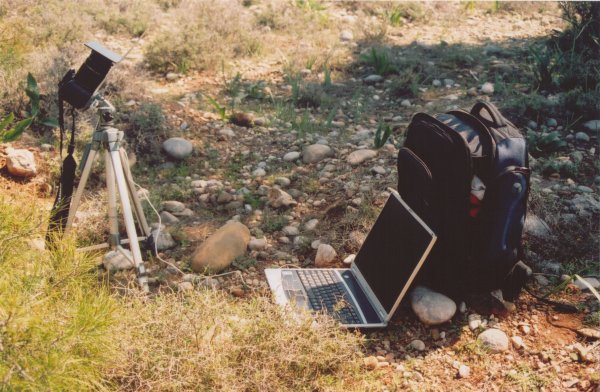
Digital SLR set-up:
A word of thanks
I'd like to thank the following people, without whom we couldn't have taken the pictures:
A word of warning
When you're going to watch an eclipse, please be very careful about damaging your eyesight. Use filters, such as those special little glasses, and don't take them off too soon. From what I've heard, it's not safe to look at the Diamond Ring without the glasses (though we did, we couldn't resist). Don't take photographs of the partially eclipsed sun without a filter. To be on the safe side, look at the LCD screen on a compact digital camera. If you're going to use a telescope, be extra super careful! Even with a filter at the telescope entrance, it may not be safe to look through the telescope. Looking through a CD is not safe (and certainly not through the hole :-) ). Looking through welding glass is usually not safe (UV is not removed sufficiently). Looking through a piece of glass with soot on it is not safe. Etcetera etcetera. When in doubt, don't. I just don't want anybody to get excited about eclipses because of this site, and then do irreparable damage to their eyes.
Further information
There are many books and internet sites on eclipses, and we looked into many of them. As far as we know, the best book by far is "Totality: Eclipses of the Sun," by Mark Littmann, Ken Willcox, and Fred Espenak (ISBN 0-19-513179-7). This book goes beyond the simplest basics, and provides a variety of information on how to experience an eclipse (what to look for, what to pay attention to), eclipses in history, some of the physics around eclipses, and eclipse photography. It also has a comprehensive appendix, that lists future eclipses upto 2052.
Fred Espenak is an astrophysicist at NASA, and apparently an eclipse expert. Search for his name on the internet and you'll find a lot of (recent) information, including lots of info on eclipse photography (this site, amongst others).